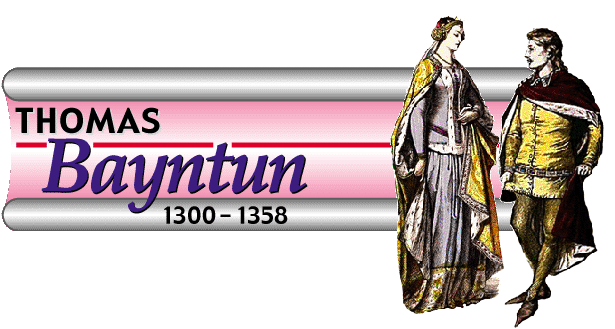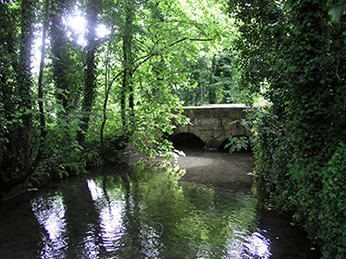
|
Timeline
1307: Edward I ruled for 35 years and died fighting the Scots at Burgh-on-Sands, Cumberland on 7th July and was buried at Westminster Abbey, Middlesex. He was succeeded by his 24 year old son, Edward II, who inherited his father’s war with the Scots. 1308: Edward II crowned King of England on 25th February at Westminster Abbey, Middlesex. 1314: The Scottish and Robert “The Bruce” expelled the English at the Battle of Bannockburn and Scotland gained its independence. The English longbow was invented at this time and as a result, plate armour was introduced. 1327: King Edward II was forced to abdicate in favour of his son, Edward III, who was crowned King of England at Westminster Abbey, Middlesex on 1st February at the age of 14. Edward II had been on the throne for 19 years, but proved very unpopular with his family towards the end of his reign and failed miserably as a king. He had been imprisoned for eight months and eventually died a terrible death at Berkeley Castle, Gloucestershire, when a red hot iron poker was thrust into his bowels on 21st September. He was buried at Gloucester Cathedral, Gloucestershire. |
Thomas de Baynton is the earliest which can, with certainty, be linked to the Bayntun family. The name in this time period is most commonly found as de Benton. However by the turn of the 17th century the spelling of the name had most definitely changed to Bayntun. A pedigree created in the 17th century traces the lineage back another seven generations to the time of Henry II, but there is no clear evidence to connect Thomas to earlier generations. It is not known where Thomas Bayntun was born, but surviving deeds record him as Thomas de Benton, or Baynton at this time. He may have had little property of his own inheritance as all the manors he was in possession of, seem to have come from his wife. He married Margaret de Grimstead on the 2nd of September 1328. She daughter of Richard de Grimstead and Edith le Tablier. She was 26 years old at the time and Tomas was 24. As a result of this marriage, he eventually acquired the Manor of Fallerston (now known as Faulston), part of the parish of Bishopstone in the Valley of Ebble, in the south of the county of Wiltshire – about 5 miles south west of Salisbury and approximately 30 miles from Bromham. Bishopstone was so called because it was a living of the Bishops in Winchester and Edington was of course rebuilt by a Bishop of Winchester. He and his family lived at Faulston House. Thomas Bayntun was not known to be a knight, although he had letters of protection for going beyond the seas on the King's business on the 26th February 1333. While he would have no expectation of receiving land initially, as Margaret de Grimstead had living brothers, his fortunate marriage would begin the process of raising the family to one of the wealthiest in Wiltshire by the 16th century. This marriage brought him the manors of Faulston, Croucheston and Throp in Wiltshire and Apsley in Sussex. The Manor of Apsley would later be known as Bentons Manor or Tabershall which is how it is referred to in Thomas de Grimstead's Inquisition Post Mortem. Records show Guy le Tablier was Lord of Fallerston before 1300 and his daughter and heiress, Edith was married to Richard de Grimstead and in possession of Fallerston in 1309. An Indenture, dated 13 Edward II (1320) shows Richard de Grimstead granting to his son Thomas, the Manor of Fallerston with parts of Croucheston, Throope and Winterbourne Orchestron in the county of Wiltshire and the Manor of Apsile in the county of Sussex. Other documents show Thomas de Grimstead, Lord of Fallerston by deeds dated 14 Edward II (1322) and 16 Edward II (1324). According to the Calendar of Patent Rolls, 16 Edward II, on the 6th February 1324, at Berkeley, a Pardon was granted to Thomas de Benton for acquiring for life from Ralph, Baron of Creystok, two parts of a moiety of the Manor of Great Benton, in the County of Northumberland, held in chief, at a rent for the first 13 years of £6 and after that of £10 a year and the reversion of the other third of the said moiety after the death of Elizabeth de Creystok, who holds it in dower, at a rent for the first 13 years of 60 shillings and after that of 100 shillings a year. Thomas de Grimstead died on the 10th May 1328 without an heir, his wife Joan, was given a third share of her husband's property. His sister, Margaret, married at the time to Thomas Bayntun and she received Faulston as part of the remaining two thirds share in the division of the property and therefore Thomas Bayntun became Lord of Faulston by right of his wife. The IPM of Thomas de Grimstead shows him holding Dontone (Dunton Chamberlain), in Bedford, Apsele (Apsley), in Sussex, Compton Chamberlain, Fallardstone (Faulston), Croucheston and Throp and Orchestone St. George, in Wiltshire with his heir being the son of his brother John, aged 2 years. A few months later in September 1328 the infant of John de Grimstead died with his heirs being his aunts Margaret, the wife of Thomas Bayntun and Katherine, the wife of Relph de Bouklande. By an agreement, Margaret was assigned Faulstone, Crouchestone, Throp and Apsley with Katherine receiving Compton Chamberlain, Orcheston St. George and Dunton. Thomas' widow Joan was assigned dower on the 10th August 1328. On the 12th August 1328 she was granted wardship of her son's lands. The payment for this was guaranteed by her future husband Robert Shaw, whom she soon remarried. Thomas Bayntun's son Nicholas, would eventally inherit the rest of the Grimstead estates, including the remaining one third share of the Manor of Faulston, as Joan died in 1340. 21 years later on the 18th September 1361 her husband's inquisition was held to clarify who held her lands and by what right. It was found that Thomas Bayntun held Faulston, Croucheston and Thrope by the courtesy of England until his death and that they were then conveyed to her son Nicholas Bayntun, aged 27 at the time. The Chapel at Faulston was not part of Faulston House. It was definitely a separate building and is described in the Inquisition Post Mortem of Richard Grimstead in 1328, with the other buildings near Faulston Manor House. It was called the Chapel of St. Andrew and St. Mary Magdalen and stood with the road to the south of it. The land in Faulston was all part of Faulston Manor. In 1328 the demesne land of the manor was said to be 250 acres of arable, 6 acres of meadow and a pasture called Oxdown, but by 1340 there were said to be only 160 acres of arable. Near the manor house was a sheepfold and a rabbit warren. Also in 1328 there were five bond tenants and eleven cottars, but by 1340 there were still five bond tenants but only three cottars. The township's open field demesne and tenantry strips were apparently intermingled and the upland pastures were used in common. On the 26th February 1333, at Pontefract, a protection, with clause, until Michaelmas for Thomas de Benton, and others, was granted, for going beyond the sea on the king's service in defence of his realm. Clearly, Thomas Bayntun just wanted to lead a simple life, without title or appointment to any office, and went to great lengths to avoid such honours. From the Calendar of Patent Rolls, Edward III, dated the 16th January 1336, at Westminster – an exemption for life was granted to Thomas de Benton, King's yeoman, from being put on assizes, juries or recognisances and from appointment as mayor, sheriff, escheator, coroner or other bailiff or minister of the king, against his will. A deed, dated 14 Edward III (1341), shows Thomas Bayntun, as Lord of Fallerston. A further deed, dated 18 Edward III (1345), shows John de Farley, a brother of Richard de Grimstead of Mull, granting Thomas de Benton of Fallerston, the entire right over Fallerston. Today there is a field known as Chapel Close alongside the site of the old house and this was clearly indicated on a map dated 1792, which might have been the site of the chapel or a field attached to the chapel. The Bayntuns did have some small properties in Croucheston and Throope, but did not have any property in Flamstone, but a deed dated 1354 of a gift of a cottage and two acres in Flamstone, was witnessed among others by Lord Thomas de Benton. There is no record of the burial place of Thomas Bayntun, but it is thought he and his descendants, may have been buried in a square field, known as Chapel Close, which might have been either the site of a Chapel or a field attached to the Chapel which was next to Faulston House. There are no visible signs of any graves today, unless buried beneath the ground. His death was listed in the Wiltshire Inquisitions Port Mortem, Edward III, a printed volume by the Wiltshire Record Society. His wife Margaret died in July (14 Edward III) 1340, aged 38 years and Thomas died on the 28th May (32 Edward III) 1358, aged 58 years. He was succeeded by his son and heir Nicholas Bayntun. |



